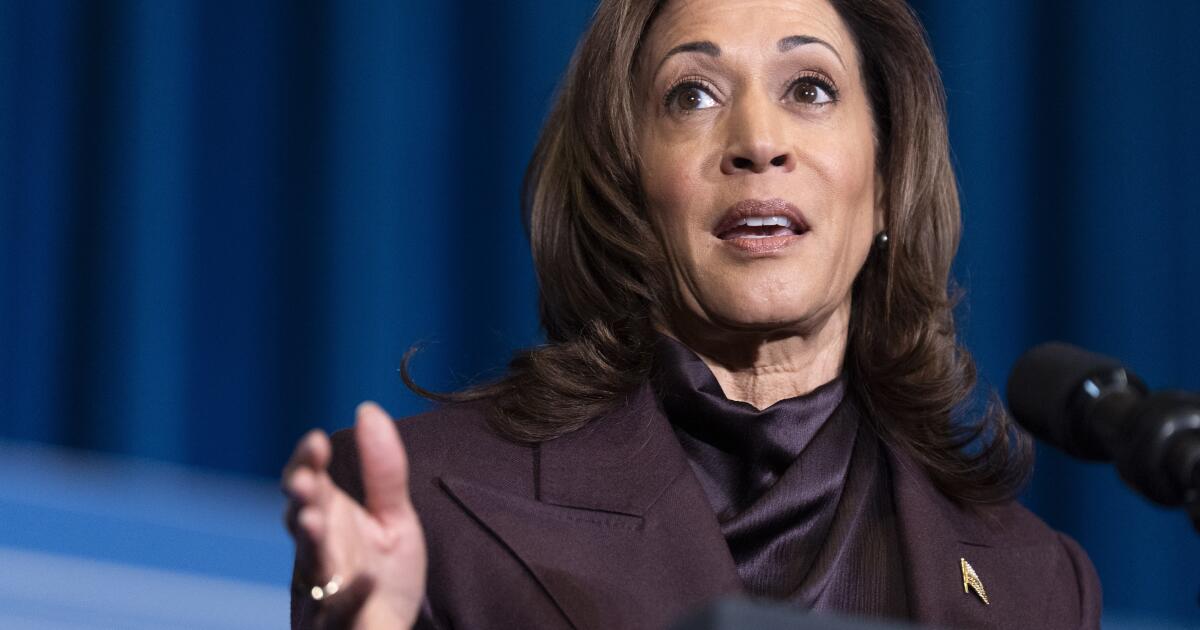SACRAMENTO — Kamala Harris could make history as the first woman and person of color to be elected California governor. But she’d need to really want the job.
She couldn’t see it as merely a consolation prize after losing the presidential election to Donald Trump. Nor could she view it as a stepping stone back to the White House.
California voters would sense those feelings and perhaps not elect her. Anyway, she’d probably be miserable in her work.
Rather, Harris would need to view the job as a probable career-capper, taking pride in solving complex problems that are eating away at her native state.
She’d have to be eager to deal with homelessness, the housing shortage, street crime, overregulation, a perpetual water shortage and the annual hassle of balancing a volatile state budget fed by an outdated tax system that should have been modernized years ago.
These black eyes on California are critical dilemmas. But absent a dedicated desire to solve them, they could be viewed as tediously boring compared to leading the nation on sweeping national issues and global diplomacy.
There’d be no playing of Hail to the Chief, no “president’s own” U.S. Marine band performing at state dinners, no private cabin aboard Air Force One -– in fact, no gubernatorial plane at all.
And unlike residing in the majestic White House with all expenses paid, there’d be no housing benefit whatsoever — unless she moved into the creaky old Victorian governor’s mansion that Gov. Gavin Newsom soon fled after being elected, buying his own large estate in the Sacramento suburbs.
Win or lose, if Harris ran to succeed the termed-out Newsom in 2026 -– as is widely speculated — her window to become president would likely be closed.
Wrong, some argue. They point to Richard Nixon, another California native.
Nixon was vice president and lost the top job to John F. Kennedy in 1960. Then he ran for California governor two years later — as Harris could — and was beaten by Democratic incumbent Pat Brown.
“Just think how much you’re going to be missing,” the bitter loser famously told reporters the morning after his embarrassing defeat. “You don’t have Nixon to kick around anymore. Because, gentlemen, this is my last press conference.”
Not quite.
Six years later, Nixon ran for president again and narrowly won. Some cite this comeback story as historic proof that a Harris race for governor could be a step back to the White House.
Here’s the fallacy in that scenario:
Nixon had six years to regroup and plan a campaign. Harris would have no grace period.
If Harris became governor in January 2027, she’d almost immediately need to begin running for president in the 2028 election. How opportunistic would that look? She’d be seen by voters everywhere as two-faced.
Harris could wait until her second gubernatorial term and run for president in 2032. But by then the political landscape will have changed. Unlike 2028, an incumbent president undoubtedly will be seeking reelection in 2032 — possibly a Democrat.
In 1968, Republican Nixon benefited greatly from a Democratic Party fractured by the Vietnam War. And if Democrat Robert F. Kennedy hadn’t been assassinated on election night after his California primary victory, I’m convinced he would have beaten Nixon in November.
Age also is a factor. Harris will be 68 in 2032. Nixon was only 55 when he won the presidency.
Harris could skip a gubernatorial bid and run again for president in 2028 when Trump is termed out. But I can’t see Democrats turning to her a second time after she lost to such a flawed human being as Trump.
Sure, the loss wasn’t all her fault. President Biden stubbornly refused to drop out of the race until it was too late for the vice president to build a strong national support base. But still she lost. And the Nixon fluke aside, parties don’t normally double down on losers.
So if she wants “to stay in the fight,” as she says, becoming governor seems her best option.
But she should expect a race, not a trot.
She’d need to raise at least $50 million — maybe $100 million-plus. And she could do that with her access to hefty donors. But it would require energy, time and an earnest sales pitch.
Harris would need a strong message — something a lot more appealing than the “we’re not going back” yawner she used against Trump.
Because, face it, she didn’t run as well in California this year as Biden did in 2020. Harris trounced Trump by 20 percentage points, but Biden walloped him by 29.
And, despite being a U.S. senator, former California attorney general and ex-San Francisco district attorney, she was running far back in the polls in her home state before dropping out of the 2020 presidential primaries.
But because of her familiarity to voters, long elective resume and fundraising ability, Harris would be the undisputed front-runner for governor.
She’d practically clear the field immediately — prompting many current Democratic candidates to drop out and several others contemplating the run to forget it. Most couldn’t raise enough bucks to compete against her. That’s unfortunately the curse of contemporary politics.
But some strong competitor would probably emerge. Maybe a moderate Democrat with barrels of money.
Harris shouldn’t linger long in deciding. If she runs, it’d be best to start erecting the campaign machinery and selling herself around the state by spring.
Should she run? Definitely — if deep down she’d love to be the powerful governor of her native state, the world’s fifth-largest economy. If she truly wants to “stay in the fight.”
